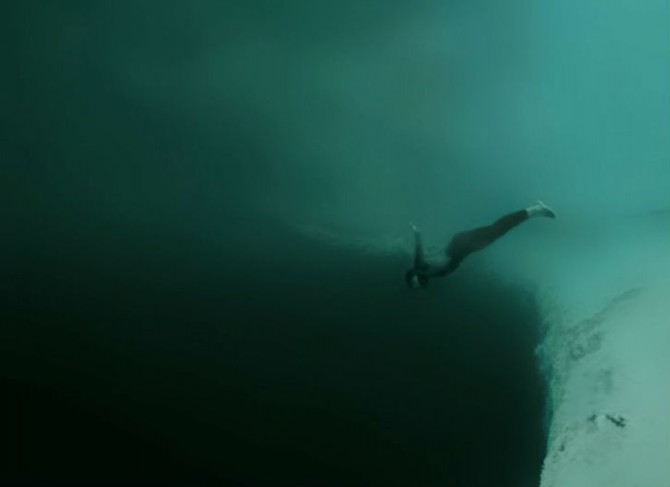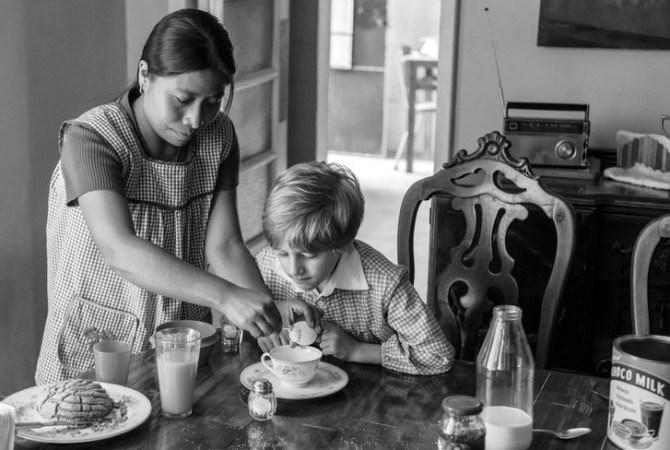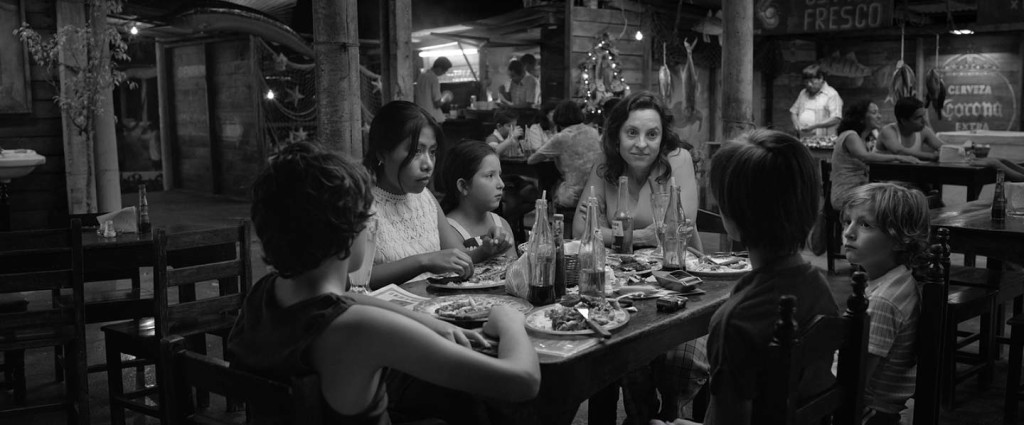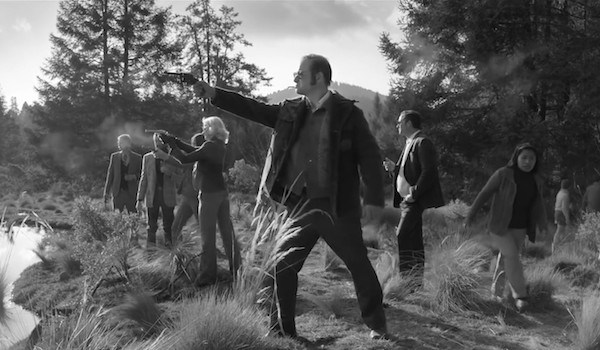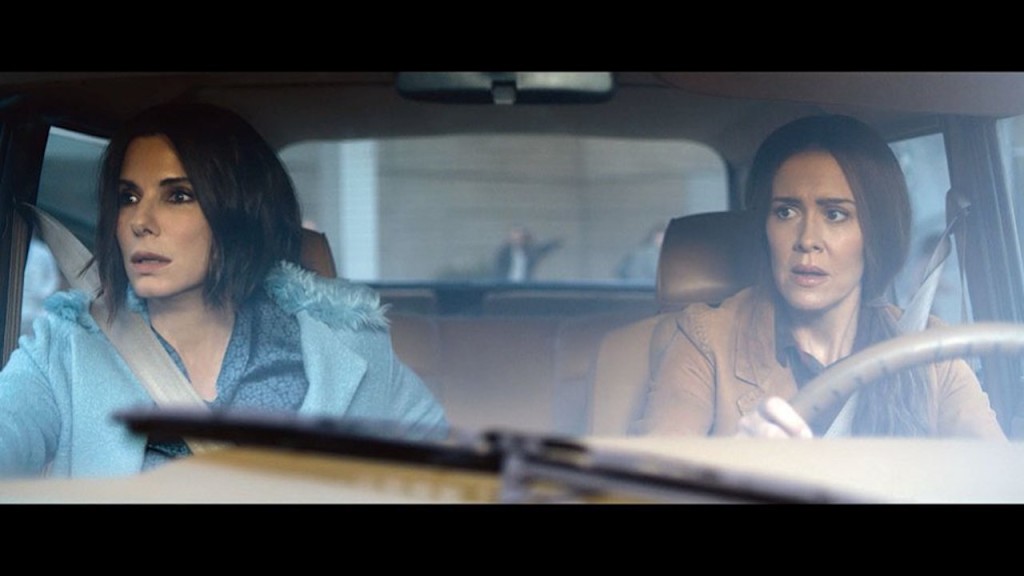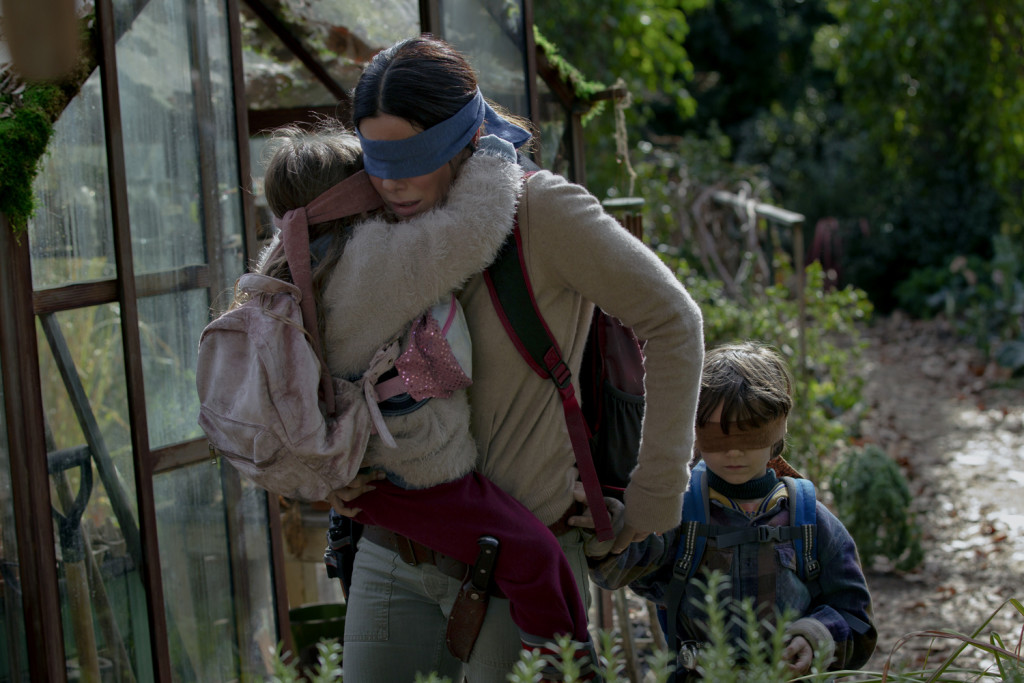Search Results for: the wall
Genre: Horror
Premise: When the crew of an oil rig begins to drill on one of the deepest stretches of the ocean floor, they awake a dark and dangerous creature that has been hidden away for hundreds of years.
About: Today’s SPEC script (Yay, go spec scripts!!!) was snatched up by Michael Bay’s Platinum Dunes production company. But the more impressive feat, without question, was making the Black List as a non-biopic. The writer, Nelson Greaves, created the “Unfriended” franchise and was a staff writer on both Sleepy Hollow and 24.
Writer: Nelson Greaves
Details: 120 pages
I was going to do a whole Oscar Theme Week, reviewing big “important” screenplays that exhibited all the qualities of an Oscar contender. But then I thought, “Screw it. Let’s have some fun.” Today we get a classic monster-in-a-box screenplay. For those who don’t know what that means, “Monster-in-a-box” movies are any movie where your heroes are trapped in a contained area with a monster. It is seen as one of the most reliable and marketable movie setups that exist.
David Travis is the captain of an oil rig at the bottom of the sea. We’re told that down here, there is no light. And that, actually, 90% of living things on this planet live in this light-less existence. So it must be a shock to these critters when this crew comes down here and lights up an entire football field worth of sea floor to get their oil rig pumping.
Along with Davis there’s attitude-to-spare, Ox, alternative Chinese-American, Jen, parent of the group, Levan, lesbian, Rae, still acts like he’s in college, Craig, and cowgirl hottie, Anna. After the crew initiates their oil slurping, it’s time for a celebration. But just as corks start popping, the entire rig goes dark. It takes a second for the power to be restored, and once it is, they discover that the lighting system outside has been damaged.
Jen heads out to fix it, but when her toolbox falls outside the lit area and down a small hill, she must retrieve it. There’s only one problem. There’s no light down there. It’s DARK. And they’ve been told never to travel into the dark. Jen’s got beer muscles from the party earlier, however, and heads out. Should we be surprised that she doesn’t come back?
Control Man Craig notices on the radar that Jen is somehow half a mile away. That’s impossible. The rest of the crew throws their suits on and goes after her… into the dark. They get to where Jen’s supposed to be but there’s nothing. “But she has to be there,” Craig pleads. “The radar says so.” That’s when someone realizes, “She’s underground.” They all start digging, find Jen’s arm, pull her up, but her entire suit is filled with guts. Eww. But wait… this isn’t Jen’s suit. This suit is older. Then someone finds a second suit under Jen. These people are not a part of their crew. What’s going on?
Craig relocates Jen’s tracker, which is further away than previously thought. They keep walking and find a giant hole on the sea floor. It appears Jen is at the bottom of that hole. David volunteers to go down, and is slowly lowered via rope. He notices that in the walls of this hole are tons of little tunnels. Who made these? Where do they go? David gets to the bottom and finds a barely conscious Jen. He grabs her and starts back up the hole. And that’s when things get bad. A giant light-sucking beast starts chasing them. It’s able to snatch poor Jen, but David gets away.
Because this beast doesn’t reflect light, the crew realizes that walking back the traditional way is a death trap. There’s no way to see if it’s coming. So they take one of the tunnels and, once below their rig, dig upwards and get back to home base that way. Somehow, this inane plan works, but getting inside the rig doesn’t solve anything. This light-sucking beast is not going to stop until it kills them all.
Fun script desired.
Fun script achieved.
Dark is by no means perfect. The dialogue, in particular, was brutal (DAVID: “Two miles. Jesus. Can you scoot under the engine, check the converter belt?” RAE: “Not for what you’re paying me.” DAVID: “I’m paying you the GDP of Tonga.” RAE: “Which I can’t collect if I’m dead.”). What does that line even mean? What’s Tonga? And how much is their GDP? And since we don’t know either of these things, how can we understand this joke? A classic “camaraderie dialogue” fail, which I’ll cover more in the “What I Learned” section.
But luckily for Dark, the pacing is excellent.
The biggest issue with these monster-in-a-box screenplays is that there’s a lot of sitting around in rooms, gearing up for the next set piece. As that formula sets in (wait around, set piece, wait around, set piece, wait around, set piece), we get used to the pacing, and once the reader gets used to anything, they become bored. After getting out on the ocean floor in Dark, Greaves not only keeps our characters moving, but keeps throwing in unexpected developments as well.
I particularly liked the addition of these tunnels and thought Greaves could’ve done even more with them. If they had to maneuver in and around these things to escape the monster, that would’ve been cool. Making their trek a straight shot back to base was fine, but felt a little ‘first idea’ to me.
This is a great conversation topic for writers. Often what will happen is towards the end of your writing process – your last couple of drafts – you’ll come up with a great new idea. But because you’re basically finished, you don’t explore the idea. I can imagine a scenario where through six drafts in Dark, the hole was just a hole. It was only on the last two drafts that the writer came up with these tunnels. And, unfortunately, two drafts isn’t enough to fully explore how those tunnels could add to the story. Which is why we got this straight shot back to base. (I don’t know that this was the case. I’m only guessing)
If this happens to you, it’s your duty to explore it, even if it’s going to extend your writing out further than you planned. Cause good ideas are hard to come by. And you don’t really get everything out of an idea unless you’ve some spent some serious time with it. There’s a version of this that plays out more like The Descent, where these tunnels lead to a larger truth about what’s living down here. But the writer didn’t go there.
Greaves could’ve also made this much better if he’d taken 5 more pages to set up his characters. These characters are thinner than an electric eel. One character is literally described as “a lesbian.” Lol. As if that tells us everything we need to know about her. I see this a lot in these types of scripts, as writers know the characters are being written to die. “Why spend all this time on setting someone up if they’re just going to die” goes the logic. You should have the opposite mindset. The better we know your characters, the more we’ll care about them. And in cliche setups like this one, good characters are often what separate the winners from the losers.
In order to write memorable characters, start with the basics. Give us a thoughtful character description that lets us know exactly who the person is. Here’s a description of Matt Drudge from the number 4 script on last year’s Black List (“Drudge has a twitchy demeanor and horrific posture. He talks with a weird sense of confidence despite a nasally voice and the occasional stutter.”). Then, ideally, you want to provide an action for that character that further defines who they are. For example, to show that Drudge is annoying, you might have him send back his breakfast at the diner because the eggs are “10 percent too runny.” If you do those two things, your characters will stand out. You still want to give them flaws and vices and inner conflicts. But everything starts with the introduction.
Dark was a good script. It’s a little derivative but it moves quickly and never gets boring.
[ ] What the hell did I just read?
[ ] wasn’t for me
[x] worth the read
[ ] impressive
[ ] genius
What I learned: Try to inject TRUTH into your camaraderie dialogue. Camaraderie dialogue (dialogue between a tight knit group/crew in a movie) is some of the most cringe-worthy dialogue I read. It’s clear the writer has never been anywhere near a military unit, or, in this case, an oil rig crew. So they write some version of camaraderie they saw in a similar movie – in other words, a copy of a copy. Don’t do this. To write good camaraderie dialogue, work off your own life. Think about any time when you and a group of friends were joking around. It’s never perfect. Nobody ever nails that trailer-ready zinger. The conversation is more raw and messy. Start there and try to find the truth of the situation, as opposed to popping in that old Aliens DVD and rewriting the scene after they come out of hyper-sleep.
Oscar Week is upon us. What better way to celebrate than review the film with the most Oscar nominations?
Genre: Drama
Premise: (from IMDB) A year in the life of a middle-class family’s maid in Mexico City in the early 1970s. Inspired by the director’s own childhood.
About: No studio would touch Roma. A black and white passion project without a single recognizable actor and a wandering unconventional narrative? It was as if the director was actively trying to make no one watch his film. However, that director, Alfonso Cuarón, knew Netflix was desperate to get that Oscar and got them to pony up the dough. It worked out for both parties. Cauron got to make his film and Netflix has the movie with the most Oscar nominations.
Writer: Alfonso Cuarón
Details: 2 hours and 12 minutes!
Everyone I’ve talked to who’s seen Roma has had the same reaction. “It was… good,” they say, the way you tell the host of a dinner party their Jamaican-inspired vegan potato salad was good. I’ll never understand the intimidation the average viewer feels to say they liked one of these “important” movies. If you don’t like something, SAY IT. You’re not wrong. We’re all entitled to our opinions.
If it sounds like I’ve got it in for this movie, let me offer some context. I have a huge issue with movies made strictly for critics. Critics aren’t real moviegoers. They don’t have to pay to see films. Movies are supposed to be made for the general population, people who pay. So when you bypass that demographic for the sole purpose of winning an award, I have no respect for you because you don’t have any respect for me. I’m a pawn being used for your awards speech.
Roma is the most relentless version of this. It is a movie that, literally, does not need an audience. It didn’t have a theatrical run so no one needed to see it. It was thrown on Netflix where, maybe, 12 people watched it all the way through. Didn’t matter. All that matters is that Netflix gets one of those gold guys.
I’ve personally attempted to watch this film half a dozen times. Every time I’ve fallen asleep within half an hour. So I drank a gallon of Coke and injected adrenaline directly into my veins, Crank style, this time in an attempt to make it through all 132 minutes of this overpriced sleeping aid in order to give you a definitive review. Let’s take a look…
Cleo is a maid. I know this because the first 30 minutes of this movie shows her cleaning the house. Eventually we learn that this is a middle class home in Mexico City at some point in the 1970s. Cleo’s love life begins to heat up when she meets a local guy who’s really into doing karate movies while naked. After the two sleep together, karate guy disappears.
Meanwhile, we spend more time in the home. More cleaning. More hanging out with the kids. More playing on the roof. More cleaning. More turning off lights. More cleaning dishes. More shots of sinks. More cleaning. More washing clothes. There’s some cleaning. Cleo and the other maid busts each other’s balls while cleaning. More drying clothes. And every once in awhile we get a very long scene of the husband or wife attempting to park their giant car in their very tiny garage. If they’d gotten rid of these scenes alone, the movie would’ve been half as long.
One day, the husband tells the wife that he’s leaving for work for several weeks. After this enormous bombshell of a plot point, we spend a lot of time either sight-seeing downtown or going out to the Mexican countryside. What these scenes have to do with the story is anyone’s guess. Might they be an excuse for some Oscar-worthy cinematography? Anyway, it eventually becomes clear that the husband isn’t coming back. Poor wife.
Meanwhile, in the other giant bombshell plot development, Cleo is pregnant! Oh no! Oh no indeed as we realize we need to spend 9 months with her to get to the end of this movie. And that’s exactly how long the rest of the movie feels. It wanders aimlessly, looking to fill in time before the climactic labor can occur. Cuarón even throws in some random riots in order to make the film look like it had a point. It didn’t. Lucky for us, the movie gives us a feel-good winner of an ending. Cleo’s baby is stillborn. Fin.
“Serious” filmmakers who care about the audience understand that storytelling is a compromise. They tell their meaningful story (the selfish part) but do so inside an entertaining package (the selfless part). Take District 9. Blomkamp wanted to say something about racism in South Africa. Did he give us a boring literal story about racism in South Africa? Of course not. Nobody would’ve watched it. He told the story through the lens of an alien arrival, using the aliens as stand-ins for the oppressed race. Not only is that WAY more effective at getting the message across, but it’s more entertaining as well.
Roma is a long dull achingly literal look at a family going through tough times. And I use that term (tough) loosely. The one thing I was looking forward to in this movie was the riots from the trailer, as they implied the movie was about something bigger. But the riots are tacked on. They don’t have anything to do with the plot. This movie comes down to two plot points – Cleo’s pregnant and the father leaves. That’s the only dramatic value you get for your two hour and 12 minute investment.
There are a select few times where these storylines resonate. It’s hard not to feel for the wife when her children spot their father running out of a movie theater with another woman after not seeing him in months. But here’s the problem. This movie is so set on being artsy (most of the film is shot like a fly on the wall, a 70s black and white Fellini version of a reality show) it forgets to do the basic things, like introduce us to characters so we KNOW THEM. I never got a single scene that featured the kids. They were always running around in the background. So how bad am I going to feel for them when their dad leaves? It’s more of a general feeling of sorrow. Like, “Man, that sucks.” It’s not that deep empathetic heavy feeling you get when a character you’ve gotten to know intimately experiences a loss.
Cuarón cares more about recreating time and place than he does these characters. We often find ourselves in random parts of the country (one day we’re on a river with a bunch of suburbanites shooting guns into the wilderness for no other reason than I assume it’s something Cuarón remembers happening as a kid). And while there’s no denying that Cuarón is a masterful filmmaker, the images are devoid of the emotion they so desperately want to convey. Why? Because there is no narrative here and no attempt to get to know these people. It is a specific person’s experience that is only meaningful to him as only he knows who these people are and how they affected him. When a blond haired Netherlandian man starts singing a sorrowful song while hundreds of locals attempt to put out a fire, I nearly yanked the wires out of my TV, ripped it off the wall, stormed up to my roof, and threw it into the street.
If you’re a cinematography geek or like foreign films with zero plot, check Roma out. There’s plenty to marvel at. But let’s be real. As a screenplay, this is an unmitigated disaster. There is no semblance of a narrative to even begin judging what’s happening storywise. It’s random, it’s pointless, and it’s boring.
[x] What the hell did I just stream?
[ ] wasn’t for me
[ ] worth the stream
[ ] impressive
[ ] genius
What I learned: There’s an old saying in writing – “No one cares about your boring life.” Everybody thinks their life is somehow worthy of a movie. If you haven’t been president, didn’t become a rags to riches success story, or weren’t involved in a national scandal, chances are your life isn’t worth telling onscreen. That doesn’t mean you can’t write about your life. You just need to find an exciting concept then subtly fit pieces of your life into the characters and events. A maid’s boring everyday life isn’t worthy of a movie. It just isn’t.
Genre: Thriller/Supernatural
Premise: (from IMDB) After a series of paintings by an unknown artist are discovered, a supernatural force enacts revenge on those who have allowed their greed to get in the way of art.
About: From longtime screenwriter Dan Gilroy comes Velvet Buzzsaw, his third directing effort. The film brings back the team of Gilroy, Gylenhaal and Russo (Nightcrawler) and debuted Friday on Netflix.
Writer: Dan Gilroy
Details:113 minutes
First of all, let me say that I love this practice of movies debuting at major film festivals then appearing on Netflix or Amazon days later. I’ve always hated hearing about Sundance movies then having no idea when or where I’d be able to see them. I might have to wait 8 months before I hear about the film again. More movies should do it like this where you hear the buzz (heh heh) then get the movie immediately. Call that a millennial mindset if you will, but I was so happy to see this up on Netflix Friday.
Now the way I see Dan Gilroy is that he’s 1 for 2. Nightcrawler was as close as we’re ever going to get to a modern day version of Taxi Driver. I loved that script from the opening page. Which makes it all the more perplexing that Gilroy followed it up with Roman J. Israel, Esq. That script was the opposite of Nightcrawler. It was verbose, unfocused, and lacked structure. Should’ve changed the “Esq” to “Ick.” I actually felt bad giving it a negative review because I thought maybe it was a super early draft. But nope. That’s the draft Gilroy went with. It’s hard to make Denzel Washington look bad. But that script achieved it.
This makes Velvet Buzzsaw the tiebreaker. If this is good, Roman was a misstep. If it’s bad, Nightcrawler was an anomaly. Time to place it up on the wall and see what this piece is about.
Josephina is a British art agent in the burgeoning LA art scene. She often rubs elbows with Morf, a bisexual art critic who she once had a fling with. The two are friendly with art gallery owner Rhodora, who has become so jaded by art that nothing impresses her anymore. Actually, that could be applied to everyone here.
After a long day, Josephina returns to her apartment where she sees that her neighbor, an old man named Vetril Dease (does anyone have a normal name in this movie?), has died in the stairway. In the coincidence of all coincidences, it turns out Vetril was an artist. But not just any artist. He was extremely talented, painting dozens of dark haunting paintings. Josephina immediately claims the paintings and starts selling them.
Morf is so taken by Dease’s work that his former feelings for Josephina are reignited. But as the two enter into a relationship, strange things begin happening around Dease’s paintings. A lowly intern crashes his car while transporting the paintings. A fellow gallery owner is found hung by his scarf near another.
It appears that these paintings are coming to life and killing the greedy art leeches who covet them. When Morf becomes the latest to see the paintings move, it’s only a matter of time before he ends up like everyone else. Unless he can figure out why Dease’s spirit is doing this and put it to rest first.
Ooh, a lot to get to with this one.
Let’s break down the first 10 pages since that’s been the theme this month.
The great thing about starting your story in a captivating manner isn’t just that it hooks the reader. It’s that it hooks an audience. It’s a good thing for the movie. Amateur screenwriters on the brink of breaking in understand this (as do struggling professionals who’ve been forgotten). They toil over those first ten pages because they know if they hook you off the bat, there’s a good change you’re going to like their script.
In Nightcrawler, Gilroy starts his screenplay with Louis Bloom stealing something. He’s immediately confronted by a cop and has to talk his way out of it. Not only is something interesting happening in this opening, but Gilroy does an excellent job establishing who Louis Bloom is through the interaction. There’s a moment where Louis says, “Excuse me, but that gate was open, sir. I was under the opinion that it was a detour. What kind of uniform is that?” Just the fact that Bloom is turning the questioning around on the cop gives us a great feel for who this person is.
But something funny happens when a screenwriter becomes an established professional, when they get to that stage where their projects are greenlit without anyone having to read their script. They get lazy with their openings. They rationalize that they can take their time, sometimes defiantly so. This can result in 20 pages going by before anything interesting happens.
Velvet Buzzsaw falls into this category. Some guy played by Jake Gylenhaal stumbles into an art showing, yet we have no idea who he is or what he does. He seems slightly arrogant and bored, but that’s all we have to go on. We watch as he ricochets between people and displays, never sure why he’s here or what he’s doing. It’s the complete opposite of Nightcrawler, which started with something happening that clearly established our hero.
We then ping pong over to the street where some British woman gets dumped on the phone. Who is this woman? What does she do? Why do we care that she just got dumped if we don’t know these things? As these questions linger, she joins us in the art showing as we continue to bounce around without purpose. Even if you make the argument that Gilroy is eschewing a compelling opening in order to introduce the cast of characters, it doesn’t work because none of these characters are well established. We only know that they work in the art world. I actually had to go to Wikipedia after the movie to find out what Josephina’s job title was. That’s bad writing.
If there’s anything I’ve learned, it’s that when the first ten pages are sloppy, you’re going to get a sloppy movie. And that’s exactly what happens. This movie is all over the place. First of all, who’s our protagonist? I thought it was Morf since we meet him first. But eventually I realize it’s Dumped Girl. And I only came to that conclusion because she’s the one who found the dead artist. But if you would’ve asked me if she was the hero before that, I would’ve said no. Morf was. Confusing confusing confusing.
On top of that, there’s no clear genre here. This starts off as a goofy satire about the art scene. Then it becomes a thriller. And then, out of nowhere, it becomes an out and out horror film, where paintings come to life. WTF??? I guess you can throw single protagonists and genre out the window if you want. There are no rules. But don’t be surprised when people leave your movie feeling like they watched some quickly thrown together experimental student film.
I mean everything was messy here. Louis Bloom was so carefully constructed, you understood him intricately. He’s a sociopathic capitalist who will try to talk his way out of anything. In contrast, Morf is vague and random. It seems like the only reason he’s bisexual is because Gilroy didn’t know how to make him interesting and threw the bisexual tag on him in the hopes that it would somehow make him more complex.
It’s becoming increasingly clear to me that filmmakers are using Netflix as a way to explore their weirder more experimental ideas that nobody else would let them make. In theory, that sounds good. In practice, it means we get movies like the pointless Mute, the jumbled Hold The Dark, the boring Roma, and now Velvet Buzzsaw, a sloppily constructed mish-mash of ideas in search of a protagonist, a genre, and a plot.
[ ] What the hell did I just watch?
[x] wasn’t for me
[ ] worth the stream
[ ] impressive
[ ] genius
What I learned: A lot of writers don’t realize how much effort screenwriters put into their dialogue. They assume the words just magically come out of the writer’s head. But how can a writer understand the way someone speaks in an industry they know nothing about? I wasn’t surprised at all, then, when I heard Gilroy’s answer to this question about how he wrote authentic “art world” dialogue. Here’s the question and answer, from a Vulture interview…
One of the elements of the film that I can imagine was fun, certainly in the writing process, was the “art-speak” — the very obtuse, heady way in which critics and gallerists and artists create meaning around their work. Did you work with anybody while writing those parts of the script, or did you just immerse yourself in that language and read a bunch of “Art in America?”
Yeah, I researched it for months, read articles, interviews; I brought in three technical advisers. And it is its own world, and it is its own sort of language. And I thought I had the language down at times, and then somebody who runs a gallery in L.A. would come in and say, “You should change that word to this, because that’s not a word we use.” And it is its own lexicon. There’s no question about it. But I like going into a world and learning the language of it.
Genre: Superhero/Procedural
Premise: (from Hit List) A grief-stricken mother sets out to murder the world’s only superhero when he accidentally kills her daughter while battling his nemesis.
About: Today’s script finished NUMBER 1 on the 2018 Hit List. As a reminder, the Hit List is a list of the year’s best SPEC scripts, not to be confused with the Black List, which includes mostly assignment work (writers getting paid before they write the screenplay). As such, Hit List screenplays tend to be a little more raw. Still, there are plenty of scripts that make both lists, which is why it’s so peculiar that this – the top script on the Hit List – didn’t even appear on the Black List. One hint may be that it’s being produced by Joel Silver. Silver isn’t interested in managing social justice quotas or biopicing cineplexes to death. He just wants to make fun kick ass films, something the Black List has mostly moved away from celebrating. The writer, Russian-born Yaroslav Altunin, got his MFA in screenwriting from UCLA, where the script won that school’s Screenwriting Showcase. Screenwriters Showcase is an annual UCLA event at the end of Spring Quarter designed to introduce outstanding student work to the industry. Students can submit feature-length and TV scripts which are read and critiqued by industry experts.
Writer: Yaroslav Altunin
Details: 92 pages
Identify a popular genre and find a new way into it.
Today’s writer takes the most popular movie genre in the world – Superhero – and asks, “What if an everyday person wanted revenge on a superhero?”
Chop out all the pomp and circumstance and instead focus on the real-life human emotions of grief and anger? Make it personal instead of pyrotechnic? Sounds interesting. Sounds like the kind of script that, if written well, could finish number one on a screenplay list. That makes me excited to check out Absence of Courage.
When we meet her, police officer Maggie Temple is inside the wreckage of her car, staring at the dead body of her teenage daughter, Alex. The Guardian, a stoic superman-like superhero, has just laid waste to downtown Los Angeles while trying to kill super-villain, Nemesis. Over 100,000 people were killed during the carnage. And Maggie blames The Guardian for it all, especially the death of her daughter.
A month later, Maggie yells at her husband for encouraging her to sit around and do nothing. She wants to get back on the beat. So she puts on her new special bionic leg (she lost a leg during the attack) and heads to work. Maggie’s thrilled to see her partner, Ray, and the two are assigned to clean-up duty. Lots of fake superhero vigilantes are running around town and it’s the cops job to keep them in order.
But work doesn’t quench Maggie’s real thirst, which is to find the real identity of the Guardian and kill him. One day, while mourning in front of the wall of casualties, Maggie meets a mysterious religious doctor named Henry, who keeps all the candles lit in front of the dead’s pictures. Maggie feels like she can trust this man and the two quickly become good friends.
But Maggie can’t shake the anger inside of her, and slowly descends into the female version of Travis Bickle. Investigating the whereabouts of the Guardian, she learns that the commissioner may have orchestrated the downtown battle to gain popularity (or something). Finally, Maggie charges into the off-limits center of the city, where she finds The Guardian waiting there (just hanging out I guess?). With the help of Nemesis, she fights him, only to learn that he’s… yeah, you’re pretty dumb if you didn’t figure this one out… Henry. Maggie, then, has to come to terms with her anger and decide if killing this man is really going to make her happier.
You can probably tell how I felt about Absence of Courage from the way I phrased my plot summary. Look, I can see how this script gained traction. It’s IP Appropriation. It’s a different way to explore superhero movies.
But man, there’s so much wrong here.
For starters, the script is achingly slow. We’d get scenes like Maggie moaning to her husband about the loss of their daughter and then, 30 pages later, we’d get that exact same scene again. There was a lot of that, where scenes either echoed or repeated stuff that had already been established. The plot had virtually zero momentum, which is hard to do when your subject matter is superheroes.
The script also suffered from something I call Inevitability Syndrome. If you’ve ever watched a sporting event – a soccer, football, tennis, basketball game. – and right from the start, one team is destroying the other, you’ve experienced this. You know, even though there’s two hours left of the game, what’s going to happen. The result is inevitable.
The way this plays out in movies is when the writer follows a genre’s tropes too closely. In this case, we’ve got a cop procedural. Maggie is attempting to find the identity of someone. So there’s a lot of “talk to this person,” “threaten that person,” “lose yourself along the way.” I felt like after page 15, I could turn to page 85 and still have a good idea of what had happened. That’s not good.
I mean even the villain was the most obvious reveal ever. When a character appears out of nowhere, befriends your protagonist for no reason, and acts really mysterious every time they’re around each other, chances are the audience is going to figure out something is up.
A little red herring action could’ve solved this problem. Add a few more characters. Have those characters acting weird too. Keep the audience off-balance. The way to defeat Inevitability Syndrome is to keep the game close. One team goes up, the other team goes up. We should have no idea how the game is going to end. And Absence of Courage might as well have plastered a giant sign at the top of the title page telling you how it was going to end because that’s how obvious it was.
To be honest, I was worried from the very first scene. We meet Maggie right after her daughter has died. There’s nothing technically wrong with this choice, but it’s a choice that has consequences. If you kill off Alex before we meet her, we never have an emotional tie to her. We never see, ourselves, what was so special about their relationship. What this forces the writer to do, then, is create that emotion via Maggie’s emotion. So we have to see Maggie complain to her husband that she can never get over her daughter. We have to see her tear up when she sees her daughter’s picture on the wall of remembrance. And that’s never EVER going to be as powerful as if we’d met Alex.
And all it needed was a two minute scene between them right before Alex was killed. That would’ve done the trick. Or you need to take advantage of the visual medium that is cinema and SHOW us that emotion, not tell us. The most recent version of this is Three Billboards. I mean who doesn’t know how painful Mildred’s loss is after putting up those billboards?
This script was an odd duck. Even beyond the things I’ve mentioned, there were these awkward choices, like the fact that Maggie had a bionic leg. Except the leg played no part in the movie whatsoever. It gets a ton of coverage as a leg of the future but it didn’t give her superpowers or anything. So why include it at all?
I don’t know, guys. I suppose I can see how this script might impress a panel of people coming out of nowhere. But when you read it with all the hype that comes from topping a major screenplay list, it’s a big letdown. Which is too bad because it’s got an interesting premise. However, this thing needs a professional grade punch-up if it’s going to be the next Hancock.
[ ] What the hell did I just read?
[x] wasn’t for me
[ ] worth the read
[ ] impressive
[ ] genius
What I learned: If you’re hiding someone’s identity, and that person’s reveal is a major part of the plot, you need plenty of red herrings. You need at least four other characters who garner suspicion from the reader. Otherwise, we’re going to know who the killer (or, in this case, superhero) is with an hour left to go.
Genre: Horror
Premise: (from IMDB) Five years after an ominous unseen presence drives most of society to suicide, a mother and her two children make a desperate bid to reach safety.
About: Bird Box started off as a novel. Screenwriter Eric Heisserer (Arrival) actually began adapting the novel before it was finished. How early on was this adaptation process? Heisserer would occasionally call Josh Malerman to see if it was okay to add something here or there in the movie, to which Malerman would reply, “Ooh, that’s good. Can I put that in the book?”
Writer: Eric Heisserer (based on Josh Malerman’s novel)
Details: 2 hour running time
It’s been a long time since I read the script for Bird Box but I remember liking it a lot. And not just for its concept. The script’s central idea – not being able to look at the monsters – was a brilliant way to keep the movie cheap. If the characters don’t see them, neither do we, and that means you get an expensive monster movie without having to create expensive monsters. And it’s not only that. Much of what scares people in horror movies isn’t the actual monster, but the threat of the monster, which is why you can get away with showing so little for so long. That’s the theory, anyway. Did this approach work for Bird Box? Let’s find out.
Bird Box had one of the best openings to a film all year. If we’re being honest, it’s hard to screw “world falling apart” openings up. Even the most basic imagery – people running for their lives, screaming, violence, chaos – is exciting to watch. But that’s been the problem as of late. Directors have been showing that and only that, and it’s gotten a bit stale. Susan Bier’s choices here feel much more intense, such as a random woman in the hospital banging her bloody head against the window than staring down the pregnant Malorie. Or Malorie’s sister, who’s trying to escape this chaos, driving them away before *seeing* one of these things, only to switch into suicide mode, weaving the car in and out of traffic while Malorie attempts to stop her. It was not only incredibly intense, but it brilliantly set up the movie’s hook – DON’T LOOK.
From there, Bird Box switches to a cross-cutting structure that stuffs Malorie into a suburban house with ten other characters right after the event, then occasionally cuts to five years later, where Malorie and two young children are attempting to navigate a boat down a river while all three are blindfolded, representing the new reality for anyone who survived the initial event. The three are attempting to get to a bunker full of people, which is conveyed via an opening radio voice over of a man explaining where the bunker is and how to get there.
So how did the movie hold up? Was it as good as the script?
For a good portion of the film, yes. Especially the first half. There was a genuine excitement born out of what just happened, not completely understanding the threat, and needing to learn the rules. John Malkovich is such a great actor and his unique personality brought an energy to the early house scenes that ensured we were always entertained.
From there, the first script change arrived (or at least, I don’t think this was in the script – maybe someone can confirm this). Bier and Heisserer expanded the mythology so that instead of only needing to see the monsters to turn suicidal, certain people would become influencers, tricking humans into believing it was okay to look, encouraging them to take off their blindfolds, only for it to be a lie. The duped party would see the monster and then commit suicide.
I understood why they did this. When you need to keep your eyes closed to live, you keep your eyes closed. Even if someone were to rip your blindfold off, you could still just shut your eyes. This way, there was an added threat. Especially because these “influencers” would pretend to be normal people. For the most part, this worked, as it led to two of the more exciting scenes in the film (a man trying to get inside of the supermarket and a man attacking the boat). It made the mythology a little murkier, but overall it was a clever choice.
Bier made a couple of choices that hurt the film, though. For starters, she placed these characters in a giant beautiful house. Not only that, but the inhabitants covered the windows with a series of perfectly crafted rainbow-esque paper, casting a beautiful spectrum of colors across the walls and characters at all times. It was in stark contrast to the dark dreary hopeless house that was painted in the script. And it wasn’t just that. It feels like more characters were added. Too many. This gave the big bright perfectly lit house a party atmosphere. I was supposed to feel scared. Instead I wanted to go out clubbing.
The critical moment for Bird Box came about 70% of the way into the film. A few scenes after letting a new member into the house, a middle aged British business man, we learn that he’s actually an influencer. He begins spouting his demon rhetoric and ripping the covering off all the windows, forcing everyone to look. One by one, all of the people start dying. If there were a meter on the side of every movie telling you, on a scale from 1 to 10, how well the current scene was working, the meter would’ve been at a 3 here. For the first time, it became evident that Bird Box’s conceit of never seeing the monsters was hurting it. This moment was the culmination of the pervious 70 minutes. It needed to be big. It needed monsters. Instead, we got a mildly threatening British man yelling a bunch of gibberish.
Another issue I wish they would’ve hashed out was the relationship between Malorie and the children. It was so cold as to be nonexistent. The reason this is a big deal is because the entire emotional thru-line of the 5 Years Later storyline is built on the connection between Malorie and those children. If you look at the major comp for Bird Box, A Quiet Place, that film put a ton of focus on establishing a connection between the parents and the children. Here they assume we’ll do that work for them, and that’s always a dangerous game to play. I never got the sense that Malorie had a connection to these two kids. I feel like that could be its own TV show – Assumptions In Screenwriting. It would cover assumptions writers make and the disastrous effects of doing so.
With that said, Bird Box is better than most of the movies Netflix makes. It’s stylish. It’s got big budget production values. The acting is strong. I have a feeling this will be a big hit for the streaming service.
[ ] What the hell did I just watch?
[ ] wasn’t for me
[x] worth the stream
[ ] impressive
[ ] genius
What I learned: I’ll leave this question up to you guys. Is never seeing the monster a good thing? Or, at some point, have you built up so much curiosity that you need to show it? Eric Heisserer, in an interview with Slash Film, is sticking to the film’s guns. “We realized the moment that one of us started talking about even small features of what the monster might be, or the antagonist, down to a specific silhouette of a shadow or an appendage that entered the frame somewhere, there was always someone else in the room who would say, “Well, that isn’t scary to me.” So it defeated the purpose. We kept pulling back.

